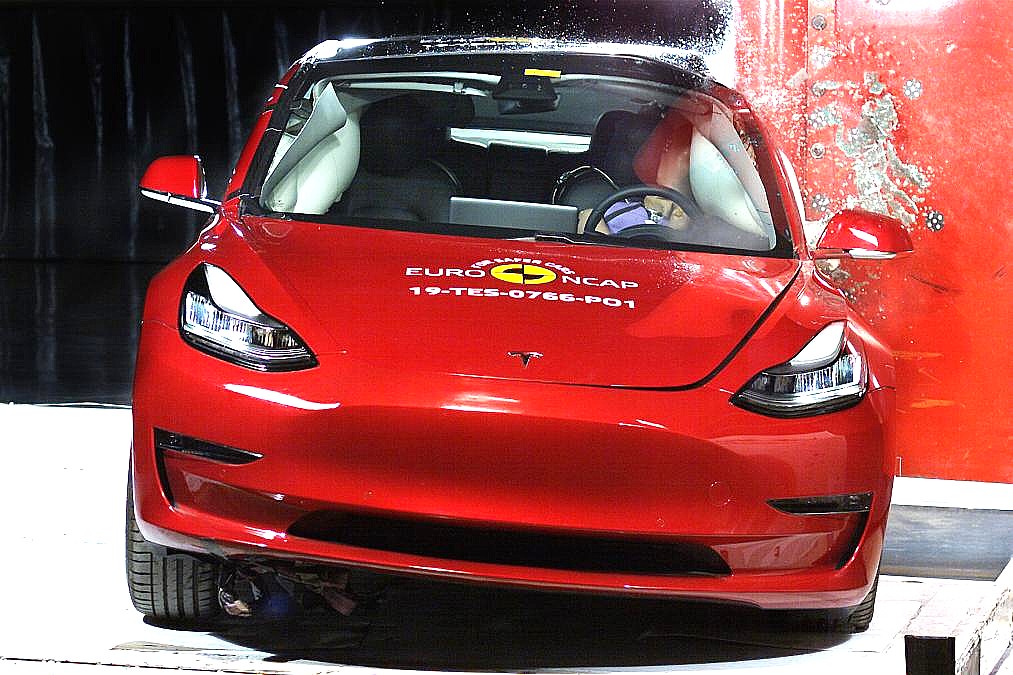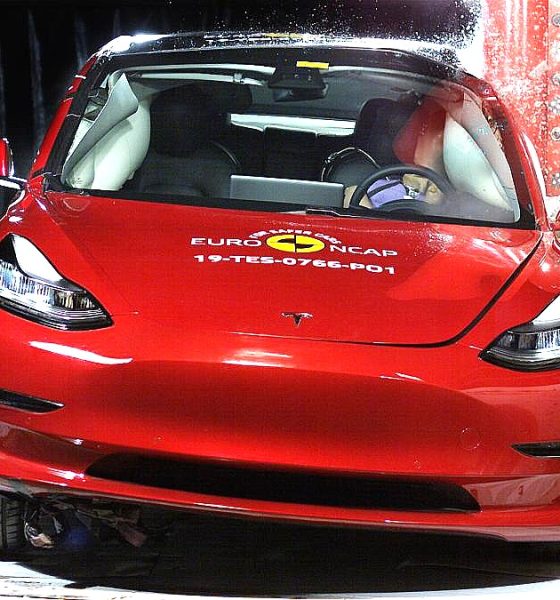

News
Tesla misses insurance firm’s ‘Safest Cars’ list because its EVs don’t crash often enough
Teslas are among the safest cars on the road, and part of this is due to their suite of active and passive safety features. From Autopilot’s capabilities to standard features like Automatic Emergency Braking, Tesla’s electric cars are designed to avoid accidents, or protect its occupants in the event that a crash is unavoidable.
Yet, despite the company’s reputation for making extremely safe vehicles, Tesla was strangely missing from a Swedish insurance firm’s recently-released list of safest cars for 2019. The reason behind this is both parts impressive and ironic at the same time.
Every year, Swedish insurance company Folksam releases the results of its annual study on the country’s safest cars, a list that was dominated this year by the Toyota Rav4. To determine which vehicles make the cut, Folksam stated that it must be able to analyze actual crash data from an ample number of collisions.
This proved problematic for Tesla’s electric cars, as the company’s vehicles simply did not crash often enough for Folksam to get enough data. This year, for example, the insurance company only recorded seven accidents from Tesla’s vehicles, which is simply too few. Anders Kullgren, Folksam’s head of research, explained to news agency NyTeknik that Tesla’s absence in the company’s safest vehicles list is due to statistics.
“We saw seven accidents with Tesla in this year’s material and that is far too little. They have very many safety systems and high security, which means that they may never be included in our lists if the cars’ (number of accidents) is too small,” he said (translated from Swedish to English using Google Translate).
Elaborating further, the Folksam head of research explained that its safest cars list is published primarily for car buyers looking to purchase used vehicles. When asked by an electric car enthusiast on Twitter why vehicles in its safest cars list require an ample number of real accidents to qualify for the firm’s rankings, Folksam responded that it actually acknowledges Tesla, which it lists as one of its recommended new cars.
Teslas are among the safest vehicles on the road today. The electric car maker’s Q2 2019 vehicle safety report showed one accident for every 3.27 million miles driven with Autopilot engaged. Vehicles without Autopilot but have Tesla’s active safety features engaged recorded one accident for every 2.19 million miles driven, and cars operating without Autopilot and active safety features enabled recorded one accident every 1.41 million miles. In comparison, the NHTSA recorded one accident for every 498,000 miles driven.
The Model 3, Tesla’s more affordable vehicle yet, has also set records with its safety features. After garnering a perfect 5-star safety rating from the NHTSA, the electric sedan also granted a perfect score by the Euro NCAP in all four of its tests’ categories. Matthew Avery, head of research at Thatcham Research, which conducts the crash tests with the Euro NCAP, stated that Tesla’s emphasis on safety was evident in the Model 3’s design and features.
“Tesla has done a great job of playing the structural benefits of an electric vehicle to its advantage. The Tesla Model 3 achieved one of the highest Safety Assist scores we have seen to date,” he said.
H/T @Dagispappan.

News
Tesla FSD fleet is nearing 7 billion total miles, including 2.5 billion city miles
As can be seen on Tesla’s official FSD webpage, vehicles equipped with the system have now navigated over 6.99 billion miles.

Tesla’s Full Self-Driving (Supervised) fleet is closing in on almost 7 billion total miles driven, as per data posted by the company on its official FSD webpage.
These figures hint at the massive scale of data fueling Tesla’s rapid FSD improvements, which have been quite notable as of late.
FSD mileage milestones
As can be seen on Tesla’s official FSD webpage, vehicles equipped with the system have now navigated over 6.99 billion miles. Tesla owner and avid FSD tester Whole Mars Catalog also shared a screenshot indicating that from the nearly 7 billion miles traveled by the FSD fleet, more than 2.5 billion miles were driven inside cities.
City miles are particularly valuable for complex urban scenarios like unprotected turns, pedestrian interactions, and traffic lights. This is also the difference-maker for FSD, as only complex solutions, such as Waymo’s self-driving taxis, operate similarly on inner-city streets. And even then, incidents such as the San Francisco blackouts have proven challenging for sensor-rich vehicles like Waymos.
Tesla’s data edge
Tesla has a number of advantages in the autonomous vehicle sector, one of which is the size of its fleet and the number of vehicles training FSD on real-world roads. Tesla’s nearly 7 billion FSD miles then allow the company to roll out updates that make its vehicles behave like they are being driven by experienced drivers, even if they are operating on their own.
So notable are Tesla’s improvements to FSD that NVIDIA Director of Robotics Jim Fan, after experiencing FSD v14, noted that the system is the first AI that passes what he described as a “Physical Turing Test.”
“Despite knowing exactly how robot learning works, I still find it magical watching the steering wheel turn by itself. First it feels surreal, next it becomes routine. Then, like the smartphone, taking it away actively hurts. This is how humanity gets rewired and glued to god-like technologies,” Fan wrote in a post on X.
News
Tesla starts showing how FSD will change lives in Europe
Local officials tested the system on narrow country roads and were impressed by FSD’s smooth, human-like driving, with some calling the service a game-changer for everyday life in areas that are far from urban centers.

Tesla has launched Europe’s first public shuttle service using Full Self-Driving (Supervised) in the rural Eifelkreis Bitburg-Prüm region of Germany, demonstrating how the technology can restore independence and mobility for people who struggle with limited transport options.
Local officials tested the system on narrow country roads and were impressed by FSD’s smooth, human-like driving, with some calling the service a game-changer for everyday life in areas that are far from urban centers.
Officials see real impact on rural residents
Arzfeld Mayor Johannes Kuhl and District Administrator Andreas Kruppert personally tested the Tesla shuttle service. This allowed them to see just how well FSD navigated winding lanes and rural roads confidently. Kruppert said, “Autonomous driving sounds like science fiction to many, but we simply see here that it works totally well in rural regions too.” Kuhl, for his part, also noted that FSD “feels like a very experienced driver.”
The pilot complements the area’s “Citizen Bus” program, which provides on-demand rides for elderly residents who can no longer drive themselves. Tesla Europe shared a video of a demonstration of the service, highlighting how FSD gives people their freedom back, even in places where public transport is not as prevalent.
What the Ministry for Economic Affairs and Transport says
Rhineland-Palatinate’s Minister Daniela Schmitt supported the project, praising the collaboration that made this “first of its kind in Europe” possible. As per the ministry, the rural rollout for the service shows FSD’s potential beyond major cities, and it delivers tangible benefits like grocery runs, doctor visits, and social connections for isolated residents.
“Reliable and flexible mobility is especially vital in rural areas. With the launch of a shuttle service using self-driving vehicles (FSD supervised) by Tesla in the Eifelkreis Bitburg-Prüm, an innovative pilot project is now getting underway that complements local community bus services. It is the first project of its kind in Europe.
“The result is a real gain for rural mobility: greater accessibility, more flexibility and tangible benefits for everyday life. A strong signal for innovation, cooperation and future-oriented mobility beyond urban centers,” the ministry wrote in a LinkedIn post.
News
Tesla China quietly posts Robotaxi-related job listing
Tesla China is currently seeking a Low Voltage Electrical Engineer to work on circuit board design for the company’s autonomous vehicles.

Tesla has posted a new job listing in Shanghai explicitly tied to its Robotaxi program, fueling speculation that the company is preparing to launch its dedicated autonomous ride-hailing service in China.
As noted in the listing, Tesla China is currently seeking a Low Voltage Electrical Engineer to work on circuit board design for the company’s autonomous vehicles.
Robotaxi-specific role
The listing, which was shared on social media platform X by industry watcher @tslaming, suggested that Tesla China is looking to fill the role urgently. The job listing itself specifically mentions that the person hired for the role will be working on the Low Voltage Hardware team, which would design the circuit boards that would serve as the nervous system of the Robotaxi.
Key tasks for the role, as indicated in the job listing, include collaboration with PCB layout, firmware, mechanical, program management, and validation teams, among other responsibilities. The role is based in Shanghai.
China Robotaxi launch
China represents a massive potential market for robotaxis, with its dense urban centers and supportive policies in select cities. Tesla has limited permission to roll out FSD in the country, though despite this, its vehicles have been hailed as among the best in the market when it comes to autonomous features. So far, at least, it appears that China supports Tesla’s FSD and Robotaxi rollout.
This was hinted at in November, when Tesla brought the Cybercab to the 8th China International Import Expo (CIIE) in Shanghai, marking the first time that the autonomous two-seater was brought to the Asia-Pacific region. The vehicle, despite not having a release date in China, received a significant amount of interest among the event’s attendees.








